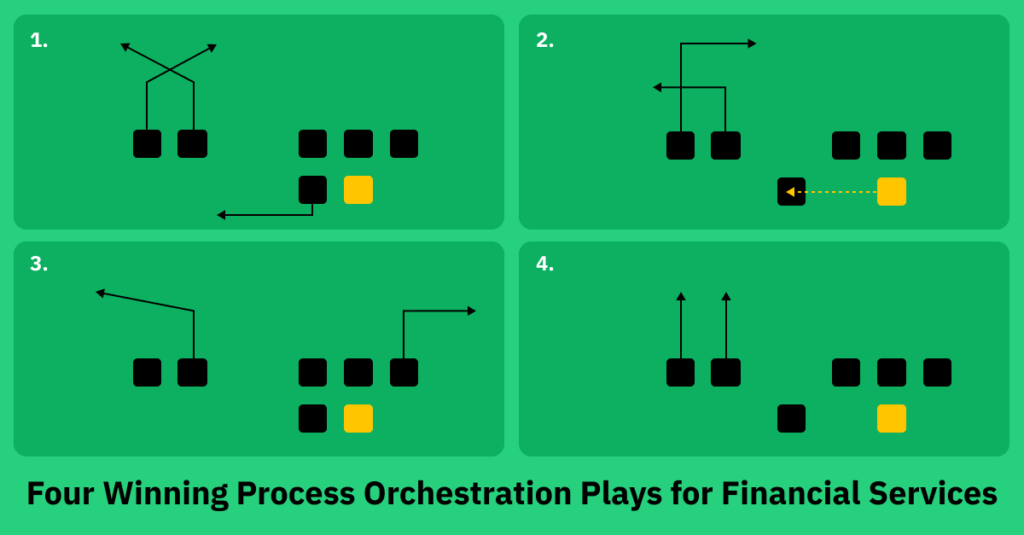
Recent events such as the failure of Silicon Valley Bank and Signature Bank have put a spotlight on the responsible governance of decisions and business processes within banks. Financial services firms—including retail and commercial banks, brokerages and investment firms—have the most to gain from process orchestration, and the most to lose without it.
While money and other instruments of value may be changing hands with each transaction, most customer interactions with a financial firm are ultimately defined by digital processes—i.e. moving data around and sharing information according to the expected customer workflow requirements and regulatory norms of the industry.
To improve a business, improve its processes. Sounds simple enough, but there are thousands of possible ways to go about this process transformation. Fortunately, there are some proven patterns to follow.
If virtually any software-and-data defined business process could be better automated, where do the firms that are most successful in process orchestration start? We gathered four winning process orchestration plays that have already yielded productive results for financial institutions.
1. Risk management
Given the current business environment, it would be irresponsible to overlook risk management processes as the lead process orchestration challenge for banks.
While all financial institutions have some form of systems in place to identify, measure, monitor, and control risk, it is far from a standardized process happening within a single application. Critical risk functions still depend largely on the expertise of executives, auditors and risk management professionals to set policies and provide oversight for ongoing operations such as loan acceptance, liquidity ratios or tax compliance.
Unfortunately, it takes a long time to build such expertise, and experienced individuals who understand the breadth of interconnected fiduciary, property, tax, money laundering, fraud, and reporting risks and requirements facing the institution will always be in short supply.
The play: Encapsulate the knowledge of the most experienced risk management professionals in administrative and operations roles, by mapping the systems they use for analysis and collaboration with others when determining policies. Process orchestration can then start to replace the need for individual involvement at each step by automating handoffs and signoffs wherever possible, while experts follow analytics for risk anomalies that require expert decisions and approvals.
2. Regulatory compliance and auditing
Regulatory pressures are also on the rise to protect national and global banking systems from well-publicized governance problems. But compliance requirements are also a knock-on effect of sophisticated criminal activity, and the shifting geo-political landscape we live in.
There are three big preventative compliance processes happening within most US and European financial services firms, though the specific regulations may vary by country or region: Know Your Customer (or, KYC), Anti-Money Laundering (or AML), and Counter-Terrorist Finance (or CTF).
Banks must conduct a series of checks when acquiring new customers or setting up additional accounts, verifying the identity of applicants, as well as the sources and potential destinations of any funds to be moved through the accounts.
Since laws vary widely between nations and states, processes must support the automated lookup of public records and commercial background checks, a decision and auditing process, and the resulting reporting of KYC/AML and anti-terrorism anomalies to appropriate authorities for that regulatory regime.
The play: Meet the complicated needs and regulatory deadlines for compliance checks and reporting, without overstretching the bank’s staff resources, or causing lengthy customer wait times.
One of Denmark’s largest international banks, Jyske Bank, used Camunda process automation software to offer as many as 20 thousand daily customer self-service account applications, with automated case handling across systems and reporting of each KYC/AML compliance check. This delivered a smooth customer onboarding (or rejection) process while saving their employees as much as 80% of the previously required manual data entry and review time, so auditors could focus on particularly critical anomalies or assisting important customers.
3. Omnichannel customer onboarding
If you are an innovation leader at a consumer bank, your growth priority should be adding new customers and protecting market share through remote account services for existing customers with an intuitive, human touch.
Banks should smooth the process of offering customer services in person, or through any channel: at home, on their phone, or even on-demand at an ATM or kiosk. The experience should be on par or better than visiting a branch office—an ideal start for each banking experience without the forms and lines.
Each new service, whether setting up a new checking account, or applying for credit cards, loans or mortgages requires lots of manual data entry steps, as well as several discontinuous record lookups, certification checks and confirmations.
The play: Process orchestration takes the reins here, putting only essential selection dialogues and confirmations in front of the customer, while pre-filling known customer information across multiple systems to avoid redundant data entry steps.
Top 10 US bank Truist Financial, fresh off a merger of larger regional banks, set out to create a net-new mobile-first onboarding experience in the cloud, atop several existing banking systems. The team selected Camunda due to its business process management capabilities with a low-code development environment they could customize as needed for security and compliance.
Their new experience automates service requests to systems such as credit bureaus, lienholder banks and insurers, regulatory and tax entities, and correlates the results. What used to be a step-by-step walkthrough in a very rigid forms-based app, or a manual process on the part of a teller or bank official now happens online, scaling in the cloud to serve a million applicants a month or more—and it can improve the bank representative or teller’s employee experience helping in-person customers as well.
4. Digital payments and global trade operations
To outsiders, the move to fully digital payments and cross-border money transfers sounds like a done deal, one of those things the global banking industry already solved thanks to the magic of the Internet. Unfortunately, it’s really not that simple, due to the technical debt of a patchwork of core systems and existing payment gateways that have been used across banks for decades.
Ask any CFO of a business that deals with high transaction volumes—they will inevitably have several people ‘working the wire’ to monitor and shepherd remittances, payments and trades through their banking systems, as well as those of trade counterparties. Adherence to strict timing and data integrity service level agreements (SLAs) between orders and settlements are extremely important in asset servicing and international trade, because asset and currency values can change so quickly.
The play: Faced with strict deadlines for making as many as 100 thousand margin calls per day, one Top 10 US bank moved its trading desk from a homegrown system to Camunda Platform to automate the matching of legal and custodian agreements with collateral requirements and timing SLA commitments.
In trade settlement operations, this global custodian bank runs thousands of daily reconciliations between custody (asset holdings) and accounting (cash movement). Any transaction that fails the reconciliation process due to an error or omission will kick off an expedited human review to ensure correct pricing and recordkeeping. By using an elastically scaling, cloud-based process orchestration platform like Camunda Platform for automated tasks as well as human inputs, this top bank’s team can maintain the true cash balance of the business even when deal volumes spike.
The Intellyx Take
Providing a seamless digital customer experience is becoming table stakes for almost all industries, but process orchestration offers a safe bet on the future for high-volume, risk-averse and highly regulated industries like banking.
Even if end customers never find out about the technical and regulatory complexity hidden behind the scenes of every interaction with the financial institution’s application estate, that’s probably for the best. Trust in an institution, and its processes, cannot be taken for granted—it is only valid when earned over time.
©2023 Intellyx LLC. Intellyx is editorially responsible for this document, and no AI chatbots were involved in writing the content. At the time of writing, Camunda is an Intellyx customer. Image sources: Ryan Dickey, Dicemanic, flickr CC2.0 license.


Start the discussion at forum.camunda.io